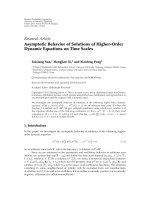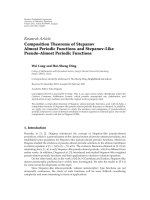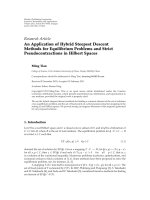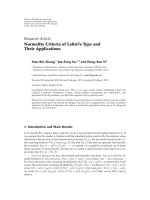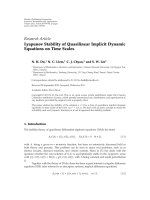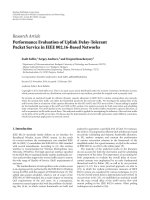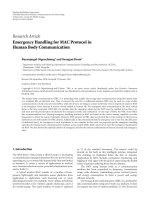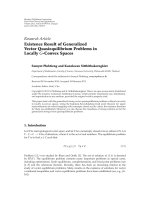Báo cáo hóa học: " Research Article General Convexity of Some Functionals in Seminormed Spaces and Seminormed Algebras" pdf
Bạn đang xem bản rút gọn của tài liệu. Xem và tải ngay bản đầy đủ của tài liệu tại đây (474.1 KB, 6 trang )
Hindawi Publishing Corporation
Journal of Inequalities and Applications
Volume 2010, Article ID 643768, 6 pages
doi:10.1155/2010/643768
Research Article
General Convexity of Some Functionals in
Seminormed Spaces and Seminormed Algebras
To do r S toya no v
Department of Mathematics, Varna University of Economics, Boulevard Knyaz Boris I 77,
Varna 9002, Bulgaria
Correspondence should be addressed to Todor Stoyanov,
Received 30 July 2010; Accepted 27 October 2010
Academic Editor: S. S. Dragomir
Copyright q 2010 Todor Stoyanov. This is an open access article distributed under the Creative
Commons Attribution License, which permits unrestricted use, distribution, and reproduction in
any medium, provided the original work is properly cited.
We prove some results for convex combination of nonnegative functionals, and some corollaries
are established.
1. Introduction
Inequalities have been used in almost all the branches of mathematics. It is an important tool
in the study of convex functions in seminormed space and seminormed algebras. Recently
some works have been done by Altin et al. 1, 2,Tripathyetal.1–6, Tripathy and Sarma
3, 4, Chandra and Tripathy 5, Tripathy and Mahanta 6, and many others involving
inequalities in seminormed spaces and convex functions like the Orlicz function.
In this paper, inequalities for convex combinations of functionals satisfying conditions
a and b are formulated in the theorems, and some corollaries are proved, using the
theorems. Condition a relates to nonnegative functionals over which the inequalities in
Theorems 1.1 and 1.4 on seminorm are proved. In Theorem 1.1, we consider seminormed
spaces, and in Theorem 1.4 seminormed algebras. Condition b relates generally to the
representations between seminormed spaces and seminormed algebras. The inequalities
formulated in this way are proved in Corollaries 1.2 and 1.5. In this paper we consider
the following generalization of the convexity in seminormed algebras. A : γf
m
i1
p
i
x
i
≤
m
i1
p
i
fx
i
, where
m
i1
p
i
1,p
i
,x
i
∈ 1fori 1, 2, ,m, ·is the norm in A,and
γ is a real number.
In order to justify our study, we have provided an example related to real functions
of one variable, similar examples can be constructed. This has been used in the geometry
2 Journal of Inequalities and Applications
of Banach spaces as found in 7, 8. Similar statements related to functionals in finite-
dimensional spaces and countable dimensional spaces have been provided in 9. These
results can be applied in the mentioned areas.
Theorem 1.1. Let X be a seminormed space over R and the nonnegative functional f satisfy the
following condition:
a gt · fy ≤ fx ≤ rt · fy, for all x,y with x/y t ∈ 0, 1,whereg,r :
0, 1 → 0, 1 are nondecreasing functions such that gt ≤ rt. Then,
1 there exists inf
α,t∈0,1
δα, tγ,where
δ
α, t
α · g
t
α · t β
β
r
α · t β
, for α ∈
0, 1
with α β 1, 1.1
2 the functions gt : 0, 1 → 0, 1 and r
−1
r
−1
: 0, ∼ → 0, ∼ are convex.
Then, if α
i
≥ 0,
m
i1
α
i
1, x
i
∈ X, i 1,n for i 1, 2, ,n, the inequality
γ · f
m
i1
α
i
· x
i
≤
m
i1
α
i
· fx
i
is satisfied.
Proof. Let x, y ∈ X,asx≤y.WeputΔα·fxβ·fy/fz, where z α·xβ·y, α ∈
0, 1,α β 1.
a Let x≤z≤y. According to condition a,weobtain
Δ ≥ α · g
x
z
β
r
z
/
y
. 1.2
Knowing that g and r are nondecreasing, we obtain
Δ ≥ α · g
x
α ·
x
β ·
y
β · r
−1
·
α ·
x
β ·
y
y
α · g
t
α · t β
β · r
−1
·
α · t β
δ
α, t
,
1.3
where t x/y.
There exists inf
α,t∈0,1
δα, tγ in compliance with 1. Therefore Δ ≥ γ.
If we put x y the result is 1 Δ≥ γ,thatis,1≥ γ.
b Let z≤x. Then, in view of a, we have
Δ ≥ α · r
−1
z
x
β · r
−1
z
x
≥ α β 1 ≥ γ. 1.4
Let us consider n elements x
i
∈ X, i 1,n, and we suppose x
1
≤x
2
≤···≤ x
n
.
Let Δ
m
i1
α
i
· fx
i
/fz, where z
m
i1
α
i
· x
i
,andt
i
x
i
/z, x
k−1
≤z <
x
k
,as1≤ k ≤ n.
Journal of Inequalities and Applications 3
According to condition a,weget
Δ ≥
m
i1
α
i
· g
t
i
m
i1
α
i
· r
−1
t
−1
i
ρ
n
α, x
, 1.5
where
α α
1
,α
2
, ,α
n
, x x
1
,x
2
, ,x
n
.
Using the principle of induction over n, we will probe that inf
n,α,x
ρ
n
α,x ≥ γ.
We know that ρ
2
α,xδα, t, and therefore about n 2 the statement is proved. We
assume the assertion about n − 1 is correct.
1 Let k ≤ 2. Then, ρ
n
α, xS α
n−1
α
n
· α · r
−1
t
−1
n−1
β · r
−1
t
−1
n
, where S is
the rest of the sum, and α α
n−1
/α
n−1
α
n
,β α
n
/α
n−1
α
n
. With condition 2 we have
ρ
n
α, x ≥ S α
n−1
α
n
· r
−1
αt
n−1
βt
n
−1
, but α ·x
n−1
β ·x
n
≤α ·x
n−1
β ·x
n
. Setting
x
n−1
α · x
n−1
β · x
n
,t
n−1
x
n−1
/z and knowing r is nondecreasing function, we obtain
ρ
n
α, x
≥ S
α
n−1
α
n
· r
−1
t
n
−1
ρ
n−1
α
, x
, 1.6
where
α
α
1
,α
2
, ,α
n−2
,α
n−1
α
n
and x
x
1
,x
2
, ,x
n−2
,x
n−1
. With the inductive
assumption, ρ
n−1
α
, x
≥ γ,thatis,ρ
n
α, x ≥ γ,thatis,Δ ≥ γ.
2 Let k ≥ 3. Then ρ
n
α, xα
1
α
2
· α · gt
1
β · gt
2
S, where S is the
rest of the sum, and α α
1
/α
1
α
2
,β α
2
/α
1
α
2
. According to condition 2,we
obtain ρ
n
α, x ≥ α
1
α
2
· α · gt
1
β · gt
2
S. Let us place t
1
x
1
/z, where
x
1
αx
1
βx
2
,butx
1
α ·x
1
β · x
2
≤α ·x
1
β·x
2
and g is a nondecreasing function.
Then, ρ
n
α, x ≥ α
1
α
2
· gt
1
S ρ
n−1
α
, x
, where α
α
1
α
2
,α
3
, ,α
n−1
,α
n
,and
x
x
1
,x
2
, ,x
n−1
,x
n
.
Applying the induction, we get Δ ≥ γ.
Corollary 1.2. Let X and Y be seminormed spaces over R and f : X → Y.TheninTheorem 1.1, one
replaces condition (a) by condition (b): gt·fy
y
≤fx
y
≤ rt·fy
Y
, for all x, y ∈ X with
x
X
/y
X
t ∈ 0, 1, and all the rest of the conditions are satisfied. Then, with α
i
≥ 0,
m
i1
α
i
1,x
i
X, i 1,n, the inequality γ ·f
m
i1
α
i
· x
i
y
≤
m
i1
α
i
·fx
i
y
is satisfied.
Proof. We consider the functional φ f
y
: X
f
−→ Y
·
y
−−−→ R
. Then, knowing b, we conclude
that φ satisfies Theorem 1.1’s conditions and hence the needed inequality.
Example 1.3. If we put in the conditions of Theorem 1.1, gtt
p
,p>1,p∈ R, rtt, and
f : R → R, t
p
fy ≤ fty ≤ tfy, t ∈ 0, 1, then about α
1
≥ 0,
m
i1
α
i
1, x
i
X, i 1,n,
we will obtain the inequality
γ · f
α
1
· x
1
··· α
n
· x
n
≤
α
1
· f
x
1
··· α
n
· f
x
n
, 1.7
where
γ 1 − p
−p−1
−1
p
−pp−1
−1
. 1.8
4 Journal of Inequalities and Applications
Proof. Let us consider δα, tα · gt/αt β β/rα · t β, where
g
t
t
p
,r
t
t, α ∈
0, 1
,t∈
0, 1
,β 1 − α. 1.9
Then, δα, tα · t/α · t β
p
β/α · t βht,
∂δ
α, t
∂t
h
t
αp
t
α · t β
p−1
β
α · t β
2
−
αβ
α · t β
2
0, 1.10
when t/α · t β
p−1
p
−1
,thatis,t/α · t β p
−p−1
−1
; hence, α · t β/t p
p−1
−1
.
Further, we obtain t βp
p−1
−1
− α
−1
. It is obvious that we have a minimum at this point in
the interval 0, 1.
Then, we obtain 1/α · t β β
−1
p
p−1
−1
p
p−1
−1
− α, and hence at the same point t
δ
α, t
α ·
t
α · t β
p
β
α · t β
α · p
−pp−1
−1
p
p−1
−1
− α
p
−pp−1
−1
1 α ·
p
−pp−1
−1
− p
−p−1
−1
≥ 1
p
−pp−1
−1
− p
−p−1
−1
γ,
1.11
since
p
−pp−1
−1
− p
−p−1
−1
≤ 0. 1.12
This confirms the assertion.
If we put p 2 in the condition of the example, we receive γ 3/4. Therefore, 3fα
1
x
1
··· α
n
x
n
≤ 4α
1
fx
1
··· α
n
fx
n
, when α
i
≥ 0,
n
i1
α
i
1,x
i
∈ X, i 1,n.
Theorem 1.4. Let A be a seminormed algebra over R with a unit. The functional f : A → R
satisfies condition (a): gt · fy ≤ fx ≤ rt · fy,forx, y as x/y t ∈ 0, 1,where
g,r : 0, 1 → 0, 1 are nondecreasing functions such that gt ≤ rt.
Besides, the following requirements are fulfilled
1 There exists inf
α,t∈0,1
δα, tλ,where
δ
α, t
α · g
t
α · t β
β
r
α · t β
, for α ∈
0, 1
, with α β 1. 1.13
2 The function, gt : 0, 1 → 0, 1 and r
−1
t
−1
: 1, ∼ → 1, ∼ are convex. Then, if
p
i
,x
i
∈ A, i 1 · n,
m
i1
p
i
1, one receives the inequality
γ · f
m
i1
p
i
x
i
≤
m
i1
p
i
· f
x
i
. 1.14
Journal of Inequalities and Applications 5
Proof. Let p, q, x, y ∈ A,asx≤y, p q 1.
We put Δp·fxq·fy/fz, where z p · x q · y.
a Let x≤z≤y. According to condition a, we have Δ ≥p·gx/z
q/rz/y≥p·gx
/p·x.
Here, we have p · x q · y≤p·x q·y,andg, r are nondecreasing.
If α p,β q, then Δ ≥ α · gt/α · t β β · r
−1
· α · t βδα, t, where
t x/y.
Then, inf
α,t∈0,1
δα, tγ exist in compliance with 1. Therefore Δ ≥ γ.
If we put x y, the result is 1 Δ≥ γ,thatis,1≥ γ.
b Let z≤x. Then, in view of the fact that a,weget
Δ ≥
p
· r
−1
·
z
x
q
r
z
/
y
≥
p
q
1 ≥ γ. 1.15
Let p
i
,x
i
∈ A, i 1 · n,as
m
i1
p
i
1. Let us put Δ
m
i1
p
i
·fx
i
/fz, where
z
m
i1
p
i
· x
i
.
We can accept x
1
≤x
2
≤···≤ x
n
.Let1≤ k ≤ n and x
k−1
≤z≤x
k
.
We have Δ ≥
m
i1
p
i
· gt
i
m
i1
p
i
· r
−1
· t
−1
i
ρ
n
p, x, where
p
p
1
,p
2
, ,p
n
,
x
x
1
,x
2
, ,x
n
,
i
x
i
z
. 1.16
Applying the principle of induction over n we will prove that ρ
n
p, x ≥ γ.Inviewofthefact
that was mentioned at the beginning, we get ρ
2
p, xδα, t ≥ γ. Assuming the statement
for n − 1 holds, we will prove it for n.
1 Let k ≤ 2.
Putting α p
n−1
/p
n−1
p
n
,β p
n
/p
n−1
p
n
, we have ρ
n
p, x
S p
n−1
p
n
· α · r
−1
t
−1
n−1
β · r
−1
t
−1
n
where S is the rest of the sum. Using condition
2,weget
ρ
n
p, x
≥ S
p
n−1
p
n
r
−1
α · t
n−1
β · t
n
−1
. 1.17
Let x
n−1
p
n−1
· x
n−1
p
n
· x
n
/p
n−1
p
n
,t
n−1
x
n−1
/z.
Since r does not decrease, and x
n−1
≤α ·x
n−1
β·x
n
, then ρ
n
p, x ≥ Sp
n−1
p
n
· r
−1
t
n−1
−1
ρ
n−1
p
, x
, where p
p
1
,p
2
, ,p
n−2
,p
n−1
,p
n−1
p
n−1
p
n
· e,
and
x
x
1
,x
2
, ,x
n−2
,x
n−1
.
By e we denote the unit of the algebra A. According to the inductive suggestion, we
obtain ρ
n
p, x ≥ ρ
n−1
p
, x
≥ γ.
2 Let k ≥ 3.
We set α p
1
/p
1
p
2
,β p
2
/p
1
p
2
.As2, we have ρ
n
p, x ≥
p
1
p
2
· gα · t
1
β · t
2
S, where S is the rest of the sum.
Let x
1
p
1
· x
1
p
2
· x
2
/p
1
p
2
,t
1
x
1
/z.
Since g does not decrease, and x
1
≤α ·x
1
β ·x
2
, then ρ
n
p, x ≥ p
1
p
2
· gt
1
S ρ
n−1
p
, x
, where p
p
1
,p
3
, ,p
n−1
,p
n
,p
1
p
1
p
2
· e,
and
x
x
1
,x
2
, ,x
n−2
,x
n−1
. According to the induction principle, we obtain ρ
n
p, x ≥
ρ
n−1
p
, x
≥ γ.
6 Journal of Inequalities and Applications
Corollary 1.5. Let A be a seminormed algebra above R with a unit, and let X be a seminormed space
over R, and f : A → X.
Then, if one replaces the condition (a) in Theorem 1.4 by condition (c): gt ·fy
X
≤
fx
X
≤ rt ·fy
X
, for all x, y ∈ A with x
a
/y
a
t ∈ 0, 1, and all the rest of the
conditions are satisfied. One denotes by ·
x
the norm in X, and the norm in A with ·
a
.Thenif
p
i
,x
i
∈ A, i 1,n
m
i1
p
i
a
1 one receives the inequality
γ ·
f
m
i1
p
i
· x
i
x
≤
m
i1
p
i
α
·
f
x
i
x
. 1.18
Proof. We consider the functional φ f
x
: A
f
−→ X
·
x
−−−→ R
. Then, knowing c,wegetthatφ
satisfies Theorem 1.1’s conditions and hence the needed inequality.
References
1 Y. Altin, M. Et, and B. C. Tripathy, “The sequence space |Np|M, r, q, s on seminormed spaces,” Applied
Mathematics and Computation, vol. 154, no. 2, pp. 423–430, 2004.
2 B. C. Tripathy, Y. Altin, and M. Et, “Generalized difference sequence spaces on seminormed space
defined by Orlicz functions,” Mathematica Slovaca, vol. 58, no. 3, pp. 315–324, 2008.
3 B. C. Tripathy and B. Sarma, “Sequence spaces of fuzzy real numbers defined by Orlicz functions,”
Mathematica Slovaca, vol. 58, no. 5, pp. 621–628, 2008.
4 B. C. Tripathy and B. Sarma, “Vector valued double sequence spaces defined by Orlicz function,”
Mathematica Slovaca, vol. 59, no. 6, pp. 767–776, 2009.
5 P. Chandra and B. C. Tripathy, “On generalised K
¨
othe-Toeplitz duals of some sequence spaces,” Indian
Journal of Pure and Applied Mathematics, vol. 33, no. 8, pp. 1301–1306, 2002.
6 B. C. Tripathy and S. Mahanta, “On a class of generalized lacunary difference sequence spaces defined
by Orlicz functions,” Acta Mathematicae Applicatae Sinica, vol. 20, no. 2, pp. 231–238, 2004.
7 R. P. Maleev and S. L. Troyanski, “On the moduli of convexity and smoothness in Orlicz spaces,” Studia
Mathematica, vol. 54, no. 2, pp. 131–141, 1975.
8 R. P. Maleev and S. L. Troyanski, “On cotypes of Banach lattices,” i n Constructive Function Theory, pp.
429–441, Publishing House of the Slovak Academy of Sciences, Sofia, Bulgaria, 1983.
9 T. S. Stoyanov, “Inequalities for convex combinations of functions,” in Proceedings of the 18th Spring-
Conference of the Union of Bulgarian Mathematicians, Albena, Bulgaria, April 1989.
